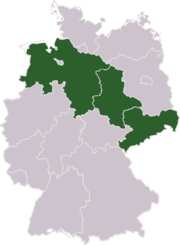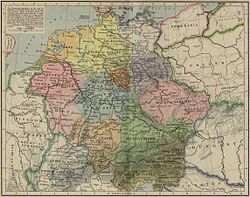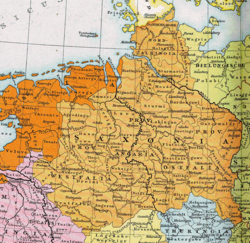- Duchy of Saxony
-
The subject of this article was previously also known as Saxony. For other uses, see Saxony (disambiguation).
Duchy of Saxony
Herzogtum SachsenStem duchy of the Frankish Empire
State of the Holy Roman Empire← 
804–1296  →
→
 →
→
 →
→The stem duchy of Saxony in 1000

Welf possessions in the 12th century,
showing the duchies of Saxony and BavariaCapital Not specified Government Principality Historical era Middle Ages - Formation of duchy
by Charlemagne
804- Welfs ascendancy 1137 - Expanded by conquest 1142 - Welfs deposed,
Ascanians enfeoffed
with severely
belittled duchy
1180- John I and Albert II
co-rulers;
- Competences divided
1260
1269, 1272 and 1282- Definite partition into
Saxe-Lauenburg and
Saxe-Wittenberg
1296- Wittenbergs extinct;
reunification failed
1422*[citation needed] The medieval Duchy of Saxony was a late Early Middle Ages "Carolingian stem duchy" covering the greater part of Northern Germany. It covered the area of the modern German states of Bremen, Hamburg, Lower Saxony, North Rhine-Westphalia, and Saxony-Anhalt and most of Schleswig-Holstein. Duke Henry the Lion occupied the area of Mecklenburg-Vorpommern.
The Saxon people were one of the most robust groups in the late tribal culture of the times, and eventually bequeathed their tribe's name to a variety of more and more modern geo-political territories from Old Saxony near the mouth of the Elbe River, up the Elbe successively to eventually, the Kingdom of Saxony and the three Germany Länder (Lower Saxony, Saxony-Anhalt, and Free State of Saxony) which bear the name today (see map below).
Contents
History
 Map showing the location of the three states, Lower Saxony in the northwest, Saxony-Anhalt in the center, and the Free State of Saxony in the southeast, within today's Germany
Map showing the location of the three states, Lower Saxony in the northwest, Saxony-Anhalt in the center, and the Free State of Saxony in the southeast, within today's Germany
 Map of Central Europe from 919-1125, by William R. Shepherd. The stem duchies are: Saxony in yellow, Franconia in blue, Bavaria in green, Swabia in light orange, Lower Lotharingia in dark pink, Upper Lotharingia in light pink, and Thuringia in dark orange.
Map of Central Europe from 919-1125, by William R. Shepherd. The stem duchies are: Saxony in yellow, Franconia in blue, Bavaria in green, Swabia in light orange, Lower Lotharingia in dark pink, Upper Lotharingia in light pink, and Thuringia in dark orange.
Middle Ages
For the early history of the Saxons before incorporation into the Holy Roman Empire, see: Old Saxony
- 804: The Duchy of Saxony (established in 785 when Widukind was installed as the first Duke of Saxony), consisting of Angria (German: Engern), Westphalia, Eastphalia and Northalbingia (today Schleswig-Holstein) becomes part of the Franconian Empire.
- 852: Liudolf, Duke of Saxony, descendant of Widukind and first of the Ottonian dynasty, founds Gandersheim Abbey.
- 880: Bruno, son of Liudolf, is killed in a battle with Vikings. His younger brother Otto becomes Duke of Saxony.
- 912: Henry, son of Otto, succeeds him as Duke.
- 919: Henry of Saxony is elected King of the Germans by the assembled Saxon and Frankish princes in Fritzlar.
- 936: Henry's son, Otto I the Great, succeeds him and is crowned in Aachen as King of the Germans.
- 938: Hermann Billung becomes margrave ("Markgraf") of Saxony.
- 953: Otto I elevates Hermann Billung to viceduke of Saxony.
- 973: Otto I dies in Memleben; Otto II becomes Emperor. Hermann Billung dies in Quedlinburg; Bernhard I Billung becomes duke of Saxony.
- 983: Danish uprising in Hedeby. Slavonian uprising in Northalbingia. Otto III becomes Emperor.
- 1002: The death of Otto III marks the end of the Saxon emperors.
- 1011: Duke Bernhard I Billung dies; his son Bernhard II becomes duke.
- 1042: Ordulf Billung, son of Bernhard II, marries Wulfhild, the half-sister of King Magnus of Denmark and Norway. Danes and Saxons fight against the Wends.
- 1059: Ordulf Billung becomes Duke after the death of his father.
- 1072: Magnus Billung becomes Duke.
- 1106: Duke Magnus dies without heir, ending the Billung dynasty. The Billung territory becomes part of the Welf and Ascanian countries. Lothar of Supplinburg becomes Duke of Saxony.
- 1112: Otto of Ballenstedt created Duke by Henry V, Holy Roman Emperor.
- 1115: Victory of Lothar of Supplinburg in the battle of Welfesholz over King Henry V.
- 1125: Lothar of Supplinburg elected as German King and crowned Emperor, as Lothar II.
- 1137 Death of Lothar. The Welf Henry X the Proud, Duke of Bavaria since 1126, becomes Duke of Saxony, as Henry II.
- 1138: Henry X tries to become king, but without success. The Ascanian Albert the Bear becomes new Duke of Saxony.
- 1139: Death of Henry X.
- 1141: Albert the Bear resigns.
- 1142: Conrad III, King of the Romans and of Germany, grants the ducal title to the Welf Henry the Lion (as Henry III). Henry the Lion gradually extends his rule over northeastern Germany. After gaining also the Duchy of Bavaria, Henry's realm covers more than two thirds of Germany from the Alps to the North Sea and the Baltic Sea, making him the mightiest ruler in central Europe.
Holy Roman Emperor Frederick I Barbarossa and his allies, many of them vassals and former supporters of his paternal cousin Duke Henry III the Lion, had defeated the latter. In 1180 Frederick Barbarossa stripped Henry the Lion of his duchies of Saxony and Bavaria. In 1182 Henry the Lion and his wife Matilda Plantagenêt, the daughter of Henry II of England and Eleanor of Aquitaine and sister of Richard Lionheart left from Stade to go into exile from the Holy Roman Empire in order to stay with Henry II of England.
Frederick Barbarossa partitioned Saxony in some dozens of territories of imperial immediacy, allotting each territory to that one of his allies who had conquered them before from Henry the Lion and his remaining supporters.
While in 1168 the Saxon clan of the Ascanians, allies of Frederick Barbarossa, had failed to install their family member Siegfried, Count of Anhalt, on the archepiscopal see of Bremen, the Ascanians prevailed twofoldly in 1180. The chief of the House of Ascania, Otto I, Margrave of Brandenburg, son of Albert the Bear, a maternal cousin of Henry the Lion, provided his sixth brother Bernard, Count of Anhalt, from then on Bernard III, Duke of Saxony, with the from then on so-called younger Duchy of Saxony (1180–1296), a radically belittled territory consisting of three unconnected territories along the river Elbe, from north west to south east, (1) Hadeln around Otterndorf, (2) around Lauenburg upon Elbe and (3) around Wittenberg upon Elbe. Except of the title, Duke of Saxony, Angria and Westphalia, which this younger Duchy of Saxony granted its rulers, even after its definite dynastic partition in 1296, this territory, consisting only of territorial fringes of the old Duchy of Saxony until 1180, had little in common with the latter.
Otto and Bernard helped their second brother Siegfried, who since 1168 had called himself the Bishop Elect of Bremen, to gain the see of Bremen, with part of the diocesan territory being upgraded to form the Prince-Archbishopric of Bremen (German: Erzstift Bremen). Thus the Prince-Archbishopric of Bremen became - among many others - one of the successor states of the old Duchy of Saxony, holding only a small part of its former territory.
The deposed ducal House of Welf could maintain its allodial possessions, which did not remain part of the severely belittled younger Duchy of Saxony after the enfeoffment of the Ascanians. The Welf possessions were elevated to the Duchy of Brunswick-Lüneburg (also Brunswick and Lunenburg) in 1235. This duchy continued to use the old Saxon coat-of-arms showing the Saxon Steed in argent on gules, while the Ascanians adopted for the younger Duchy of Saxony their family colours, a barry of ten, in sable and or, covered by a crancelin of rhombs bendwise in vert, symbolising the Saxon dukedom.
In 1269, 1272 and 1282 the co-ruling brothers John I and Albert II gradually divided their governing competences within the then three territorially unconnected Saxon areas (Hadeln, Lauenburg and Wittenberg), thus preparing a partition.
After John I had resigned in 1282 in favour of his three minor sons Eric I, John II and Albert III, followed by his death three years later, the three brothers and their uncle Albert II continued the joint rule in Saxony.
In 1288 Albert II applied at King Rudolph I for the enfeoffment of his son and heir Duke Rudolph I with the Palatinate of Saxony, which ensued a long lasting dispute with the eager clan of the House of Wettin. When the County of Brehna was reverted to the Empire after the extinction of its comital family the king enfeoffed Duke Rudolph. In 1290 Albert II gained the County of Brehna and in 1295 the County of Gommern for Saxony. King Wenceslaus II of Bohemia succeeded in bringing Albert II in favour of electing Adolf of Germany as new emperor: Albert II signed an elector pact on 29 November 1291 that he would vote the same as Wenceslaus. On 27 April 1292 Albert II, with his nephews still minor, wielded the Saxon electoral vote, electing Adolf of Germany.
The last document, mentioning the joint government of Albert II with his nephews as Saxon fellow dukes dates back to 1295.[1] The definite partitioning of the Duchy of Saxony into Saxe-Lauenburg (German: Herzogtum Sachsen-Lauenburg), jointly ruled by the brothers Albert III, Eric I and John II and Saxe-Wittenberg (German: Herzogtum Sachsen-Wittenberg), ruled by Albert II took place before 20 September 1296. The Vierlande, Sadelbande (Land of Lauenburg), the Land of Ratzeburg, the Land of Darzing (today's Amt Neuhaus), and the Land of Hadeln are mentioned as the separate territory of the brothers.[2] Albert II received Saxe-Wittenberg around the eponymous city and Belzig. Albert II thus became the founder of the Ascanian line of Saxe-Wittenberg.
Members of the Welf cadet branch House of Hanover later became prince-electors of Brunswick-Lüneburg (as of 1692/1708), kings of Great Britain, Ireland (both 1714), the United Kingdom (1801) and Hanover (1814).
Territories seceded from Saxony following its break-up in 1180
A number of seceded territories even gained imperial immediacy, while others only changed their liege lord on the occasion. The following list includes states that existed shortly after 1180 in the territory of the former stem duchy in addition to the two legal successors of the stem duchy, the Ascanian Duchy of Saxony centered around Wittenberg and the Duchy of Westphalia held by the archbishops of Cologne.
- County of Bentheim
- County of Blankenburg, until 1180 a Saxon fief, then a fief of the Prince-Bishopric of Halberstadt
- Prince-Archbishopric of Bremen
- County of Bruchhausen
- County of Brunswick, later the Duchy of Brunswick-Lüneburg (1235), the Welf allodial possessions
- Abbacy of Corvey
- County of Delmenhorst
- County of Diepholz
- County of Everstein
- Abbacy of Gandersheim
- Prince-Bishopric of Halberstadt
- Prince-Bishopric of Hildesheim
- County of Hohenstein, seated in Hohenstein
- County of Holstein
- County of Hoya
- Lordship of Lippe, an allodial possession within the Duchy of Saxony until 1180, gaining disputed imperial immediacy
- Prince-Bishopric of Lübeck
- Prince-Archbishopric of Magdeburg
- County of Mansfeld
- County of Mark
- Prince-Bishopric of Minden
- Prince-Bishopric of Münster
- County of Oldenburg
- Prince-Bishopric of Osnabrück
- Prince-Bishopric of Paderborn
- Abbacy of Quedlinburg
- Prince-Bishopric of Ratzeburg
- County of Ravensberg
- Prince-Bishopric of Schwerin
- County of Tecklenburg
- Prince-Bishopric of Verden
- County of Waldeck
- County of Wernigerode
- Duchy of Westphalia and Angria
See also
- Saxony (disambiguation)
- History of Saxony
- Rulers of Saxony
Notes
- ^ Cordula Bornefeld, "Die Herzöge von Sachsen-Lauenburg", in: Die Fürsten des Landes: Herzöge und Grafen von Schleswig, Holstein und Lauenburg [De slevigske hertuger; German], Carsten Porskrog Rasmussen (ed.) on behalf of the Gesellschaft für Schleswig-Holsteinische Geschichte, Neumünster: Wachholtz, 2008, pp. 373-389, here p. 375. ISBN 978-3-529-02606-5
- ^ Cordula Bornefeld, "Die Herzöge von Sachsen-Lauenburg", in: Die Fürsten des Landes: Herzöge und Grafen von Schleswig, Holstein und Lauenburg [De slevigske hertuger; German], Carsten Porskrog Rasmussen (ed.) on behalf of the Gesellschaft für Schleswig-Holsteinische Geschichte, Neumünster: Wachholtz, 2008, pp. 373-389, here p. 375. ISBN 978-3-529-02606-5
Categories:- Former principalities
- Former countries in Europe
- States of the Holy Roman Empire
- States and territories established in 804
- States and territories disestablished in 1296
- History of Lower Saxony
- History of Schleswig-Holstein
- History of North Rhine-Westphalia
- History of Saxony-Anhalt
- Duchy of Saxony
Wikimedia Foundation. 2010.


